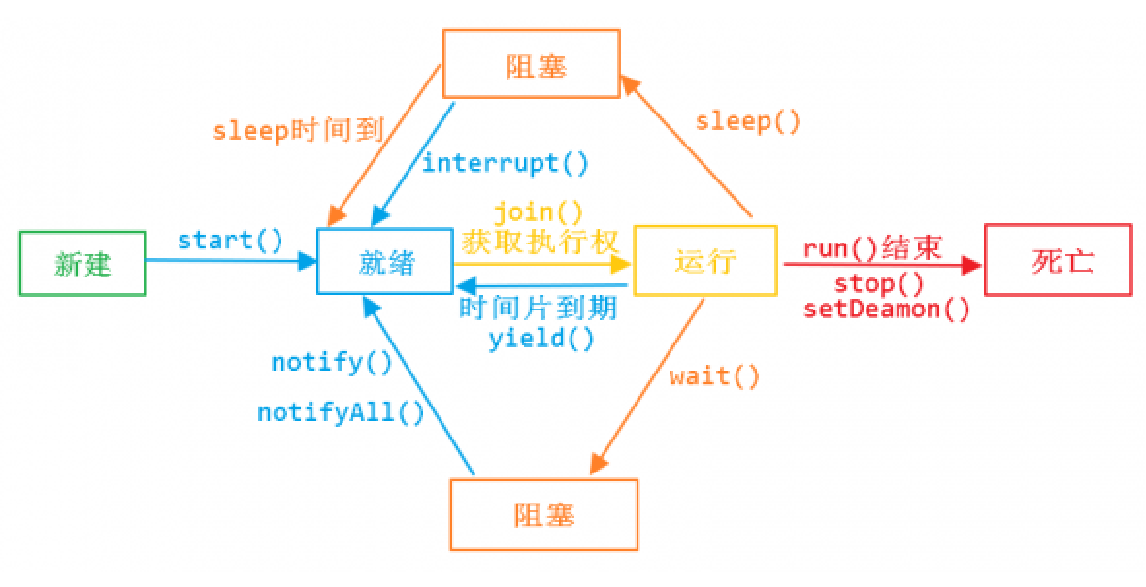java--浅谈线程(二、线程的方法和状态)
1.线程的状态介绍:

说明:
线程共包括以下5种状态。
1. 新建状态(New) : 线程对象被创建后,就进入了新建状态。例如,Thread thread = new Thread()。
2. 就绪状态(Runnable): 也被称为“可执行状态”。线程对象被创建后,其它线程调用了该对象的start()方法,从而来启动该线程。例如,thread.start()。处于就绪状态的线程,随时可能被CPU调度执行。
3. 运行状态(Running) : 线程获取CPU权限进行执行。需要注意的是,线程只能从就绪状态进入到运行状态。
4. 阻塞状态(Blocked) : 阻塞状态是线程因为某种原因放弃CPU使用权,暂时停止运行。直到线程进入就绪状态,才有机会转到运行状态。阻塞的情况分三种:
(01) 等待阻塞 -- 通过调用线程的wait()方法,让线程等待某工作的完成。
(02) 同步阻塞 -- 线程在获取synchronized同步锁失败(因为锁被其它线程所占用),它会进入同步阻塞状态。
(03) 其他阻塞 -- 通过调用线程的sleep()或join()或发出了I/O请求时,线程会进入到阻塞状态。当sleep()状态超时、join()等待线程终止或者超时、或者I/O处理完毕时,线程重新转入就绪状态。
5. 死亡状态(Dead) : 线程执行完了或者因异常退出了run()方法,该线程结束生命周期。
2.线程基本方法介绍:
1. wait(), notify(), notifyAll()等方法介绍
在Object.java中,定义了wait(), notify()和notifyAll()等接口。wait()的作用是让当前线程进入等待状态,同时,wait()也会让当前线程释放它所持有的锁。而notify()和notifyAll()的作用,则是唤醒当前对象上的等待线程;notify()是唤醒单个线程,而notifyAll()是唤醒所有的线程。
Object类中关于等待/唤醒的API详细信息如下:
notify() -- 唤醒在此对象监视器上等待的单个线程。
notifyAll() -- 唤醒在此对象监视器上等待的所有线程。
wait() -- 让当前线程处于“等待(阻塞)状态”,“直到其他线程调用此对象的 notify() 方法或 notifyAll() 方法”,当前线程被唤醒(进入“就绪状态”)。
wait(long timeout) -- 让当前线程处于“等待(阻塞)状态”,“直到其他线程调用此对象的 notify() 方法或 notifyAll() 方法,或者超过指定的时间量”,当前线程被唤醒(进入“就绪状态”)。
wait(long timeout, int nanos) -- 让当前线程处于“等待(阻塞)状态”,“直到其他线程调用此对象的 notify() 方法或 notifyAll() 方法,或者其他某个线程中断当前线程,或者已超过某个实际时间量”,当前线程被唤醒(进入“就绪状态”)。
2. 为什么notify(), wait()等函数定义在Object中,而不是Thread中
Object中的wait(), notify()等函数,和synchronized一样,会对“对象的同步锁”进行操作。
wait()会使“当前线程”等待,因为线程进入等待状态,所以线程应该释放它锁持有的“同步锁”,否则其它线程获取不到该“同步锁”而无法运行!
OK,线程调用wait()之后,会释放它锁持有的“同步锁”;而且,根据前面的介绍,我们知道:等待线程可以被notify()或notifyAll()唤醒。现在,请思考一个问题:notify()是依据什么唤醒等待线程的?或者说,wait()等待线程和notify()之间是通过什么关联起来的?答案是:依据“对象的同步锁”。
负责唤醒等待线程的那个线程(我们称为“唤醒线程”),它只有在获取“该对象的同步锁”(这里的同步锁必须和等待线程的同步锁是同一个),并且调用notify()或notifyAll()方法之后,才能唤醒等待线程。虽然,等待线程被唤醒;但是,它不能立刻执行,因为唤醒线程还持有“该对象的同步锁”。必须等到唤醒线程释放了“对象的同步锁”之后,等待线程才能获取到“对象的同步锁”进而继续运行。
总之,notify(), wait()依赖于“同步锁”,而“同步锁”是对象锁持有,并且每个对象有且仅有一个!这就是为什么notify(), wait()等函数定义在Object类,而不是Thread类中的原因。
(所以说唤醒就是开锁,而锁又在对象中,所以定义在了Object中)
3. yield()介绍
yield()的作用是让步。它能让当前线程由“运行状态”进入到“就绪状态”,从而让其它具有相同优先级的等待线程获取执行权;但是,并不能保证在当前线程调用yield()之后,其它具有相同优先级的线程就一定能获得执行权;也有可能是当前线程又进入到“运行状态”继续运行!
4. yield() 与 wait()的比较
我们知道,wait()的作用是让当前线程由“运行状态”进入“等待(阻塞)状态”的同时,也会释放同步锁。而yield()的作用是让步,它也会让当前线程离开“运行状态”。它们的区别是:
(01) wait()是让线程由“运行状态”进入到“等待(阻塞)状态”,而不yield()是让线程由“运行状态”进入到“就绪状态”。
(02) wait()是会线程释放它所持有对象的同步锁,而yield()方法不会释放锁。
// YieldLockTest.java 的源码 public class YieldLockTest{ private static Object obj = new Object(); public static void main(String[] args){ ThreadA t1 = new ThreadA("t1"); ThreadA t2 = new ThreadA("t2"); t1.start(); t2.start(); } static class ThreadA extends Thread{ public ThreadA(String name){ super(name); } public void run(){ // 获取obj对象的同步锁 synchronized (obj) { for(int i=0; i <10; i++){ System.out.printf("%s [%d]:%d\n", this.getName(), this.getPriority(), i); // i整除4时,调用yield if (i%4 == 0) Thread.yield(); } } } } }
t1 [5]:0 t1 [5]:1 t1 [5]:2 t1 [5]:3 t1 [5]:4 t1 [5]:5 t1 [5]:6 t1 [5]:7 t1 [5]:8 t1 [5]:9 t2 [5]:0 t2 [5]:1 t2 [5]:2 t2 [5]:3 t2 [5]:4 t2 [5]:5 t2 [5]:6 t2 [5]:7 t2 [5]:8 t2 [5]:9
结果说明:
主线程main中启动了两个线程t1和t2。t1和t2在run()会引用同一个对象的同步锁,即synchronized(obj)。在t1运行过程中,虽然它会调用Thread.yield();但是,t2是不会获取cpu执行权的。因为,t1并没有释放“obj所持有的同步锁”!
5. sleep()介绍
sleep() 定义在Thread.java中。
sleep() 的作用是让当前线程休眠,即当前线程会从“运行状态”进入到“休眠(阻塞)状态”。sleep()会指定休眠时间,线程休眠的时间会大于/等于该休眠时间;在线程重新被唤醒时,它会由“阻塞状态”变成“就绪状态”,从而等待cpu的调度执行。
6. sleep() 与 wait()的比较
我们知道,wait()的作用是让当前线程由“运行状态”进入“等待(阻塞)状态”的同时,也会释放同步锁。而sleep()的作用是也是让当前线程由“运行状态”进入到“休眠(阻塞)状态”。
但是,wait()会释放对象的同步锁,而sleep()则不会释放锁。
下面通过示例演示sleep()是不会释放锁的。
// SleepLockTest.java的源码 public class SleepLockTest{ private static Object obj = new Object(); public static void main(String[] args){ ThreadA t1 = new ThreadA("t1"); ThreadA t2 = new ThreadA("t2"); t1.start(); t2.start(); } static class ThreadA extends Thread{ public ThreadA(String name){ super(name); } public void run(){ // 获取obj对象的同步锁 synchronized (obj) { try { for(int i=0; i <10; i++){ System.out.printf("%s: %d\n", this.getName(), i); // i能被4整除时,休眠100毫秒 if (i%4 == 0) Thread.sleep(100); } } catch (InterruptedException e) { e.printStackTrace(); } } } } }
说明:主线程main中启动了两个线程t1和t2。t1和t2在run()会引用同一个对象的同步锁,即synchronized(obj)。在t1运行过程中,虽然它会调用Thread.sleep(100);但是,t2是不会获取cpu执行权的。因为,t1并没有释放“obj所持有的同步锁”!
注意,若我们注释掉synchronized (obj)后再次执行该程序,t1和t2是可以相互切换的。
7. interrupt()方法介绍:
package com.youyou.ch1.safeend; import java.text.SimpleDateFormat; import java.util.Date; /** *类说明:如何安全的中断线程 */ public class EndThread { private static SimpleDateFormat formater = new SimpleDateFormat("yyyy-MM-dd HH:mm:ss_SSS"); private static class UseThread extends Thread{ public UseThread(String threadName){ super(threadName); } @Override public void run() { String threadName = Thread.currentThread().getName(); while (!isInterrupted()){ System.out.println("UseThread:"+formater.format(new Date())); System.out.println(threadName+" is run!"); } System.out.println(threadName+" interrput flag is "+isInterrupted()); } } public static void main(String[] args) throws InterruptedException { Thread endThread = new UseThread("endThread"); endThread.start(); System.out.println("Main:"+formater.format(new Date())); Thread.sleep(500); System.out.println("Main begin interrupt thread:"+formater.format(new Date())); endThread.interrupt(); } }
package com.youyou.ch1.safeend;
public class EndRunnable {
public static class UseRunnable implements Runnable{
@Override
public void run() {
String threadName = Thread.currentThread().getName();
while (!Thread.currentThread().isInterrupted()){
System.out.println(threadName + " is run!");
}
System.out.println(threadName + " isInterrupted flag is = " +
Thread.currentThread().isInterrupted());
}
}
public static void main(String args[]) throws InterruptedException {
UseRunnable useRunnable = new UseRunnable();
Thread thread = new Thread(useRunnable,"endThread");
thread.start();
Thread.sleep(20);
thread.interrupt();
}
}
package com.youyou.ch1.safeend; import java.text.SimpleDateFormat; import java.util.Date; public class HasInterrputException { private static SimpleDateFormat formater = new SimpleDateFormat("yyyy-MM-dd HH:mm:ss_SSS"); private static class UseThread extends Thread{ public UseThread(String name){ super(name); } @Override public void run(){ String threadName = Thread.currentThread().getName(); while (!isInterrupted()){ try { System.out.println("UseThread:"+formater.format(new Date())); Thread.sleep(3000); } catch (InterruptedException e) { //当跑出异常的时候,标志位还会被致为false,程序还是会执行,要是想中断, //还需要在这个地方再次调用.interrupt() 方法; System.out.println(threadName+" catch interrput flag is " +isInterrupted()+ " at " +(formater.format(new Date()))); e.printStackTrace(); } } System.out.println(threadName+" interrput flag is " +isInterrupted()); } } public static void main(String args[]) throws InterruptedException { Thread endThread = new UseThread("yyThread"); endThread.start(); System.out.println("Main:"+formater.format(new Date())); Thread.sleep(800); System.out.println("Main begin interrupt thread:"+formater.format(new Date())); endThread.interrupt(); } }
7. start() 和 run() 区别介绍:
package com.youyou; /** * Thread的run()方法和start方法区别; * run() -- 作为了普通方法 * start() -- 才是线程开始情况 */ public class ThreadStartAndRun { public static class ThreadRun extends Thread{ @Override public void run(){ int i = 90; while (i > 0){ try { Thread.sleep(1000); System.out.println("i am " + Thread.currentThread().getName() + " and now the i = " + i); } catch (InterruptedException e) { e.printStackTrace(); } } } } public static void main(String[] args) { ThreadRun run = new ThreadRun(); run.setName("youyou"); //run.run(); run.start(); } }



